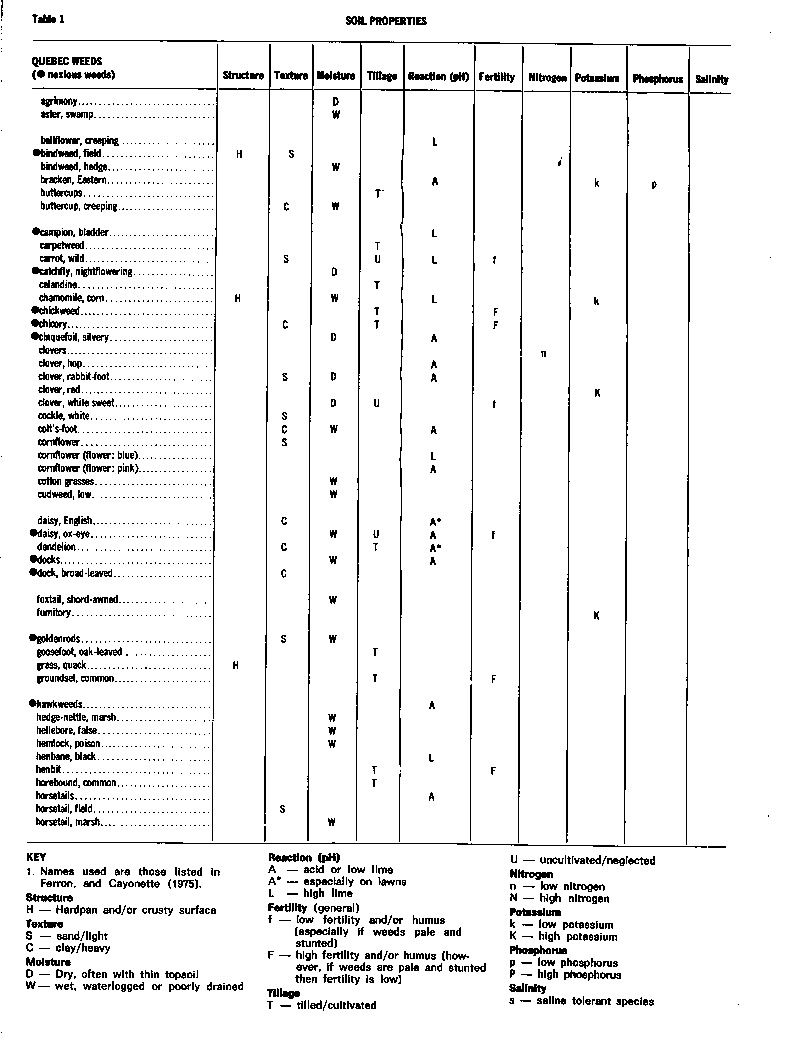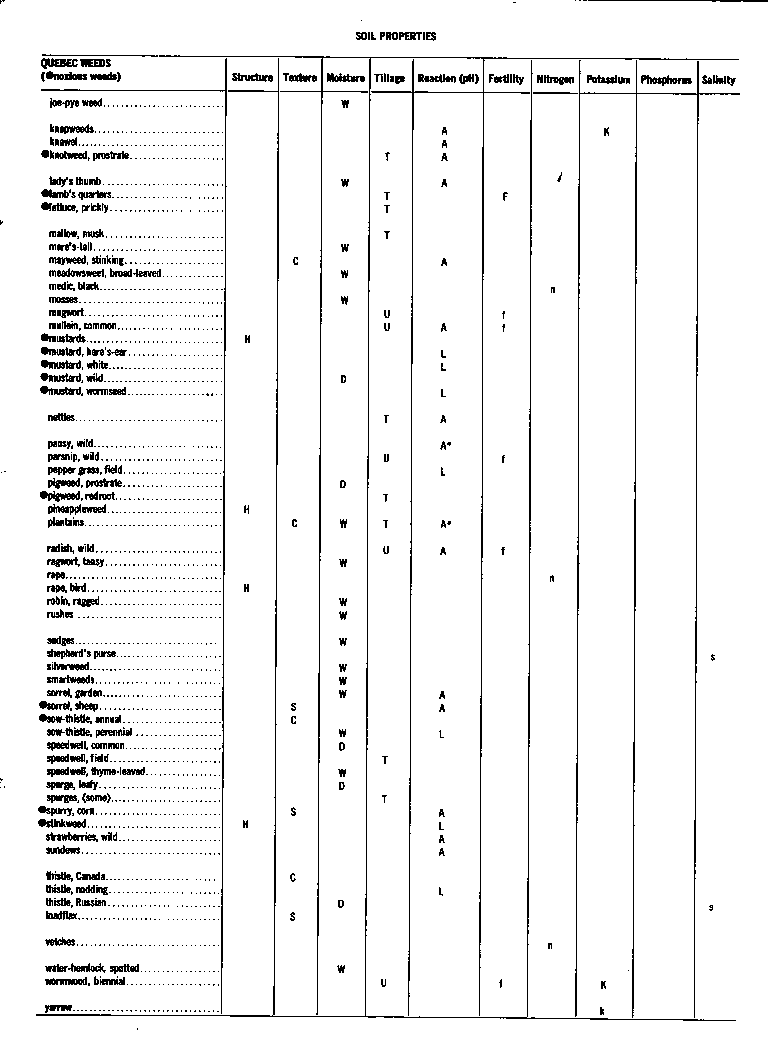

EAP Publications | Virtual Library | Magazine Rack | Search
Join the Ecological Solutions RoundtableEAP Publication - 67
by Stuart B. Hill and Jennifer Ramsay
Confronted with a weedy field or garden, one's instinctive reaction is to rush out and destroy the weeds before they take over. Perhaps we imagine them choking out our plants, or, at least, stealing the fertilizer applied for our crop. This attitude towards weeds has predominated throughout history. In 110 AD Plutarch wrote "The richest soil if uncultivated produces the rankest weeds" (Lives: Coriolanus); and more recently Oscar Wilde wrote "The vilest deeds like poison weeds Bloom well in poison air" (The Ballad of Reading Gaol).
Only Lowell and Emerson have injected a ray of hope for the weed. Lowell I suggested that "A weed is no more than a flower in disguise" (A Fable for Critics); and Emerson asked, "What is a weed? A Plant whose virtues have not yet been discovered" (Fortunes of the Republic). Could weeds really have some virtues, a beneficial side to their character? It seems unlikely. Well, yes, actually weeds do have some points, in their favour. For example:
1) Many weeds protect our topsoil from the eroding forces of rain, wind, and sun, especially when the crop cover is poor.
2)By providing a cover vegetation, weeds enable beneficial soil animals to be active at the surface, depositing their nutrient-rich faeces and/or acting as biological control agents against various insect pests.
3) Many weeds, particularly perennials, possess extensive root systems that penetrate deep into the subsoil, breaking it up and enabling the less vigorous roots of some of our crop plants to penetrate further into the soil. Some roots, such as the leafy spurge, grow to depths of four to eight feet, whereas Canada thistle roots may penetrate to depths of 20 feet.
4) Breaking up the subsoil also improves drainage and creation.
5) Deep penetration by their roots often enables weeds to accumulate various elements from the subsoil, particularly trace elements, and transport them to the soil surface. Through the weed's subsequent death and decomposition, these elements become available to crop plants with less extensive root systems. Different"accumulator" plants concentrate different elements. Interestingly, the accumulated elements are often those in which the particular soil is deficient. Some farmers have utilized this property of certain weeds by employing them as green manure. For example, Rogers et a/. (1939) found that a local case of Floridian disease in corn, called white bud, was associated with zinc deficiency and could be prevented by allowing zinc accumulator weeds to develop during fallow years.
6) Weeds that accumulate different elements have also been used by prospectors. By analyzing different parts of the plants for high concentration of certain minerals, they have been able to determine the location of mineral deposits such as copper and selenium (Brooks, 1 9721.
7) Weeds have also been used as indicators of the presence and quality of ground water (Chikishev, 1965).
8) In the past, weeds have often been used both as food and as pharmaceutical products. Interest in these uses and in their development as resources for various industrial products is currently growing in the "developed world".
9) However, the primary value of weeds under consideration in this article is their ability to reveal information about the properties of our soils, particularly their nutritional status, pH, and presence of a hardpan. Frederick Clements (1920), the eminent U.S. botanist explained this property when he stated: "Each plant is an indicator. This is an inevitable conclusion from the fact that each plant is the product of the conditions under which it grows, and is thereby a measure of these conditions. As a consequence, any response made by a plant furnishes a clue to the factors at work upon it".
Since many weeds are "specialists" they are likely to be particularly useful as indicators. Different weeds are adapted to different ranges of environmental variables and are able to grow only where their particular needs are met. For example, certain species, such as knawel, are confined to acid soils, while others are limited to basic soils.
The use of weeds as soil indicators is not a new concept. In 50 AD, the great Roman scholar, Pliny the Elder observed that land supporting wild plum, elder, oak, and thimbleberry was also favourable for wheat production. Many North American immigrants chose land for their farms according to the vegetation it supported. They quickly recognized that white pine--Norway pine-- jack pine communities were characteristic of sandy soils of little agricultural value, whereas forests of birch, beech, maple, or hemlock indicated more fertile soils.
It has been shown that the tall-grass prairies are suitable for orchards, cereals, hay, and fodder crops, while bunch grass regions are more suitable for wheat and grass production (Shantz 1911, Sampson 1939). Wire grass areas are less productive and short grass communities least productive. Highly alkaline soils are unsuitable for arable use and are characterized by tussock grass, salt grass, and greasewood (Hilgard 1906).
The information on weed indicator species is poorly documented, much of it residing only in the minds of observant farmers and gardeners. In preparing the list of weeds in Table 1, numerous sources, some reliable and some undoubtedly less reliable, were consulted. Consequently, the information contained in it should be used as a basis for further observation and research rather than as a guarantee of what to expect from a soil. Before using such a table, there are several things to consider:
11) Some weeds have "ecotypes"
Populations of a particular weed growing in different locations may differ slightly from each other in their appearance and requirements; they are referred to as "ecotypes". Thus, the ecotype of a particular weed in one area may be more tolerant of acid soil conditions than the ecotype of the same species in another area.
12) Limits of tolerance to environmental factors vary
Plants, including weeds, differ enormously in their degree of tolerance to changes in soil pH, moisture content, etc.; and some have a narrow tolerance for one variable but a wide tolerance for others. The best indicators are those with narrow tolerances because they would only be found associated with specific conditions.
(3) Plants may be sensitive to several environmental factors
When we look at Table 1 we notice that many of the plants are listed in more than one category of environmental factors. For instance, perennial sow thistle and docks are both indicators of wet areas; however, the thistle has a preference for more acid soils whereas docks are found in soils with a high lime content. Thus, when interpreting the presence of a weed we need to know all the factors to which it is responding.
14) Perennial weeds often make better indicators than annuals
Perennial weeds, having been able to tolerate the conditions in a particular locality for more than one year, are often more reliable indicators than annuals, which may survive only one season.
(5) Weed communities are better indicators than single species
The presence of a group of weeds that are associated with one another because of similar requirements for certain soil conditions provides a more reliable indicator in contrast to a single weed species, which may only indicate chance establishment.
16) Growth characteristics of a weed may be as revealing as its presence
The growth characteristics of weeds and the colour of their leaves and flowers may be as important as their presence in revealing information about the soil. A vigorous growth of leguminous weeds usually indicates a soil lacking in nitrogen; as does the presence of stunted nonleguminous weeds with pale green leaves. Cornflowers make particularly useful indicators as their flowers are blue when found on soils with a high lime content but are pink when they are growing on acid soils.
The observant farmer and gardener will notice subtle changes in the weed populations on his land in response to his agricultural practices. As his soil improves he may find that chickweed, chickory, common groundsel, common horehound, and lambsquarter become the dominant weeds. However, if he finds that the daisy, wild carrot, mugwort, common mullein, wild parsnip, wild radish, and biennial wormwood become dominant, he should review his practices as these weeds thrive on soils of low fertility. The addition of well-balanced compost, organic manures, and other fertilizers together with certain tillage and drainage practices may be required to bring the soil back into production.
We are not advocating that all weeds be encouraged indiscriminately, for even "beneficial" weeds poorly managed, will reduce yield. What we are suggesting is that by being able to identify the weeds on our land and know what their presence indicates, we will be in a better position to manage our soils wisely.


Brooks, R. R. 1972. Geobotany and bio-geochemistry in mineral exploration. 290 pp. Harper and Row, NY.
Chikishev, A. G. (ed.) 1965. Plant indicators of soils, rocks, and subsurface waters. 210 pp. Consultants Bureau, NY.
Clements, F. E. 1920. Plant indicators: the relation of plant communities to process and practice. Carnegie Inst. Wash., Publ. No. 290. 388 pp.
Cocannouer, J. A. 1964. Weeds: Guardians of the Soil. 179 pp. DeVin-Adair, NY.
Dale, H. M. 1966. Weed complexes on abandoned pastures as indicators of site characteristics. Can. J. Bot. 44: 11-17.
Dale, H. M., P. J. Harrison and G. W. Thomson. 1965. Weeds as indicators of physical site characteristics in abandoned pastures. Can. J. Bot. 43: 1319-1327.
Ferron, M., and R. Cayonette. 1975. Noms des Mauvaises Herbes du Ouébec. 3rd edn. Agr. Que. OA38 R4-4. 113 pp.
Hilgard, E. W. 1906. Soils; their formation, properties, composition, and relations to climate and plant growth in the humid and arid regions. 593 pp. Macmillan, NY.
Mueller-Dombois, D. and H. Ellenberg. 1974. Aims and Methods
of Vegetation Ecology. 547 pp. Wiley, NY.
Pfeiffer, E. E. 1974. Weeds and what they tell. 96 pp. Bio-dynamic Farming and Gardening Assoc., Springfield, IL.
Rogers, L. H., O. E. Gail and R. M. Barnette. 1939. The zinc content of weeds of volunteer grasses and planted land covers. Soil Sci. 47: 237-243.
Sampson, A. W. 1939. Plant indicators-- concept and status. Bot. Rev. 5: 155-206.
Shantz, H. L. 1911. Natural vegetation as an indicator of the capabilities of land for crop production in the Great ' Plains area. U.S.D.A. Burl Pl. Ind.
Bull 201: 1-100.
Shewell-Cooper, W. E. 1975. Soil Humus and Health; an Organic Guide. David and Charles, Newton Abbot, Engl.
Soil Association. 1975. The value of weeds. 2nd edn. 22 pp. Soil Assoc. Walnut Tree Manor, Haughley, Suffolk, Engl.
ADDITIONAL REFERENCES
FOR IDENTIFYING WEEDS
Frankton, C. and G. A. Mulligan. 1970. Weeds of Canada. 2nd edn. 217 pp. Can. Dept. Agric. Publ. 948. Can. Dept. Agric.,
Ottawa.
Isely, D. 1960. Weed identification and control in the North Central States. 400 pp. Iowa St. U. Pr., Ames, lo.
Jacques, H. E. 1959. How to know the weeds, 230 pp. Brown, Dubuque, lo.
Marie-Victorin, Frère. 1964. Flore Laurentienne. 2nd edn. 925 pp. Presses de ['Univ. Montréal, Montréal, Oue.
Peterson, R. T. and M. McKenny. 1968. A field guide to the wildflowers of Northeastern and North Central North America. 420 pp. Houghton Mifflin Boston, MA.
Copyright © 1977 Ecological Agriculture Projects
Info Request | Services | Become EAP Member | Site Map
Give us your comments about the EAP site
Ecological Agriculture Projects, McGill University (Macdonald
Campus)
Ste-Anne-de-Bellevue, QC, H9X 3V9 Canada
Telephone:
(514)-398-7771
Fax:
(514)-398-7621
Email: eapinfo@macdonald.mcgill.ca
To report problems or otherwise comment on the structure of this site, send mail to the Webmaster